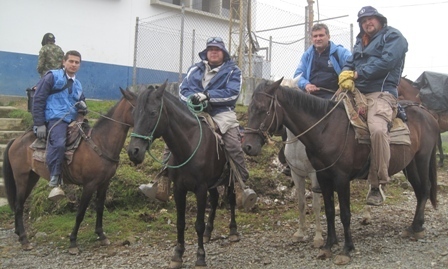
Going the extra mile... On a mule...
“After seven hours riding that mule, all I wanted to do was rest. But of course we didn’t. That is not the nature of our work…” Winson Beltran, UN Department of Safety and Security (UNDSS)

In April 2010, a complete upgrade of the Common Security Telecommunications Systems (CSTS) in Colombia was conducted by UNDSS and WFP FITTEST (UN World Food Programme Fast IT and Telecommunications Emergency and Support Team). In just three months the team of four technicians travelled to 22 different sites across the country assessing, installing and upgrading equipment.
The team, consisting of Vitaliy Salkov and Aleksander Dulovic from FITTEST and Winson Beltram and Oscar Ariza from UNDSS, were not only faced with a short deadline and a large number of installations, but also extremely erratic weather conditions causing difficulty accessing sites.
“Weather conditions were tough,” said Vitaliy. “There were times when Oscar and I were at the top of the mast installing an antenna and when we looked at each other, we realised we had frost on our faces.” At another location, persistent rain caused a landslide which blocked the path that the team needed to take. “We could not access the site by car, so we went on horses and mules,” said Aleksander. “And then there were sites that the horses couldn’t even access, so we went on foot!”
Colombia currently has the second highest number of displaced people in the world. At the end of 2009 there was an estimated 4.9million displaced people across Colombia; approximately 10.8% of the country’s total population. This, combined with extreme weather conditions and its susceptibility to natural disasters, means that reliable emergency telecommunications systems are crucial.
As part of the mission, the team upgraded nine repeater sites across Colombia and installed a further seven. A repeater is a device that receives a signal, such as radio waves, and retransmits it at a higher level or higher power so that it can cover longer distances.
The installation of a repeater involves climbing up a pre-existing mast and connecting an antenna to it. These masts can be over 60m high. “The height of the mast and the landscape of Colombia meant that we were climbing to around 4000m above sea level,” said Vitaliy. “We had some breathing problems due to the altitude. Once we were on the tower, whatever we had to lift felt 10 times heavier than what it had weighed on the ground.”
In addition to the numerous installations, a condensed version of the IT Emergency Management training course was conducted in the capital, Bagota. Funded by the Vodafone Foundation, United Nations Foundation and World Food Programme partnership, the training is designed to train humanitarian IT officers how to effectively and efficiently manage the IT response to an emergency situation. A total of 26 IT officers, from seven different UN agencies, completed the training with participants coming from all over the region.
Like many missions, the team said that the camaraderie was the best part. “When you go to the field with someone, you make friends for life,” said Aleksander. “You can work with someone in an office for years and not really know what they are like. Being in the field fast tracks the process because you are together all the time and you are sharing everything.”
“What I most liked about this mission was the professional interaction accompanied with the personal enrichment,” said Winson. “My three team members are not only excellent professionals, but amazing people.”
The equipment installed across Colombia was required to ensure the country has necessary infrastructure for essential security communications. The CSTS upgrade will enhance humanitarian response capacity by providing dependable communications networks. The systems will also help to improve field coordination and enhance staff security.
“With the work that we accomplished, aid workers now have reliable telecommunications systems in Colombia to facilitate their programmes” said Winson.
FITTEST is a team of IT, telecommunications and electrical specialists from the United Nations World Food Programme (WFP) that assist the humanitarian community in establishing and maintaining IT infrastructure systems. The upgrade mission was directed in 2010 by WFP in its capacity as lead of the Emergency Telecommunications Cluster (ETC).